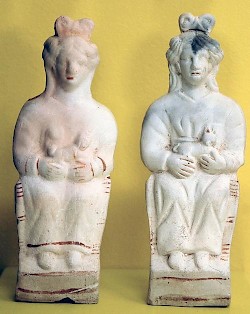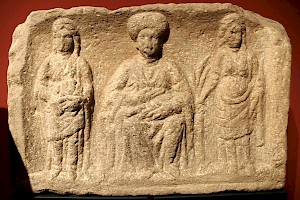Matres
Matres or Matronae (litt. "Mothers"): ancient deities, venerated in northwestern Europe.

The cult of the three matres or matronae (both words mean "mothers") is known from Gaul (including Germania Inferior and Superior), northern Spain, and northern Italy. This region is more or less identical to that of the La Tène-culture (the Celts), which suggest a Celtic origin of this cult, which is only known from the Roman age. There are two concentrations of monuments: northern Italy and the country along the Lower Rhine, where the Ubians lived.
The mothers are best known from dozens of votive altars, on which they are shown seated. In the northern (Ubian) group, the two women left and right wear large hats, and are sometimes shown with trees. Among the other attributes are fruits and animals. The mothers of this group closely resemble the pre-Germanic and pre-Celtic goddess Nehalennia.

Those depicted on the non-Ubian monuments are often influenced by the Greek and Roman artistic traditions, e.g. depictions of the goddess Cybele.
The most remarkable aspect of this cult is the endless variety of (Celtic, Latin and Germanic) names. For example, we know that there were Alaferhuic mothers, Cartovallensic, Rumaneheic and Vatviaic-Nersihenic mothers. These names are believed to be topographical and may refer to springs, but this is an invalid argument, because the ancient topographical names are almost all unknown. Other names describe qualities of the mothers, like the Matres Paternae ("fatherly mothers" or "ancestral mothers"). Some triplets seem to have limited their activities to one single ethnic unit, like the Hamavehic and the Hiannanefatic mothers of the Chamavi and Cananefates - both living in the country that is now called The Netherlands. The shrine of the Aufanian mothers was at Bonn.
It is a colorful set of names, but it is hard to give an interpretation of this cult. The first one to do so was the Roman general Julius Caesar, who wrote in the sixth book of his famous Commentaries on the War in Gaul that the Gauls venerated Minerva. Several modern scholars have taken this as a reference to the mothers. We know that in the continental Celtic religion triplism played a role. From Medieval Irish sources we know that the great goddess, queen Morrígan, resolved into three Morrígna: Morrígan, Badb, and Nemain. This would explain why Caesar could describe the triple goddess with one name.

There is a big problem with this interpretation, however. The ancients regarded the Irish and Britons as ethnically distinct from the European Celts. (The modern use of "Celtic" to describe the inhabitants of Britain and Ireland has no ancient antecedents.) This is confirmed by linguistic evidence: the Irish spoke Q-Celtic, but the worshippers of the mothers lived in regions where Gaulish, Lepontic, and Hispano-Celtic had been spoken. This makes it difficult to use Irish evidence to explain continental beliefs.
It is usually assumed that the mothers were protective deities. There is much to be said for this interpretation, because several inscriptions mention gratitude for received support. Moreover, the mothers are usually shown with fruits and animals, which can be interpreted as gifts to mankind.
Probably, this is correct, but it must be noted that we cannot be absolutely certain. The quantity of names is disquieting. We must admit the possibility that
- there are many types of mothers and
- not all mothers were protectors.

There are many religions in which almost identical images are used to depict completely different powers, only insiders being capable of seeing the difference. Today, few non-Catholics will be able to distinguish Saint Frances from Saint Antony, and few western visitors to Iran will see the difference between Imam Husein and Iman Ali.
The fact that the mothers are shown with fruits is not really conclusive; it is possible that some mothers are shown with gifts to mankind, and others with the objects they have stolen. (If we did not know the story of Pandora's box, we would interpret her name and image as if she were some sort of mother goddess.) Another interpretation is that the mothers are depicted with gifts they have received. It cannot be excluded that the mothers were not protective deities, but had a far more complex and ambiguous nature, like our fairies.
 Jülich, Dedication to the Rumanehabian Mothers |
 Nettersheim, Dedication to the Aufanian Mothers |
 Bonn, Dedication to the Aufanian Mothers |
 Bürgel, Dedication to the Matres |
We have already noted that the spread of the cult of the mothers is more or less identical to the spread of the La Tène-culture. This suggests that the cult has Celtic origins. Again, this is probably correct, but again, there is some disquieting evidence. The oldest monuments dedicated to the mothers dates from the mid-first century CE, from southern Gaul - a heavily romanized part of the empire. After a quarter of a century, the custom to make votive altars had spread to northern Italy (the first of the two regions with many monuments), and after a century to the Ubians (the other region). This does not exclude the possibility that there was a Celtic element in the cult of the mothers, but things appear to have been more complex. If the mothers would not have had Celtic and Germanic names, archaeologists would have interpreted the cult as Roman.
We are left with a triplet of (probably) protective deities that was (probably) originally Celtic. But the interpretation is plagued with many uncertainties.